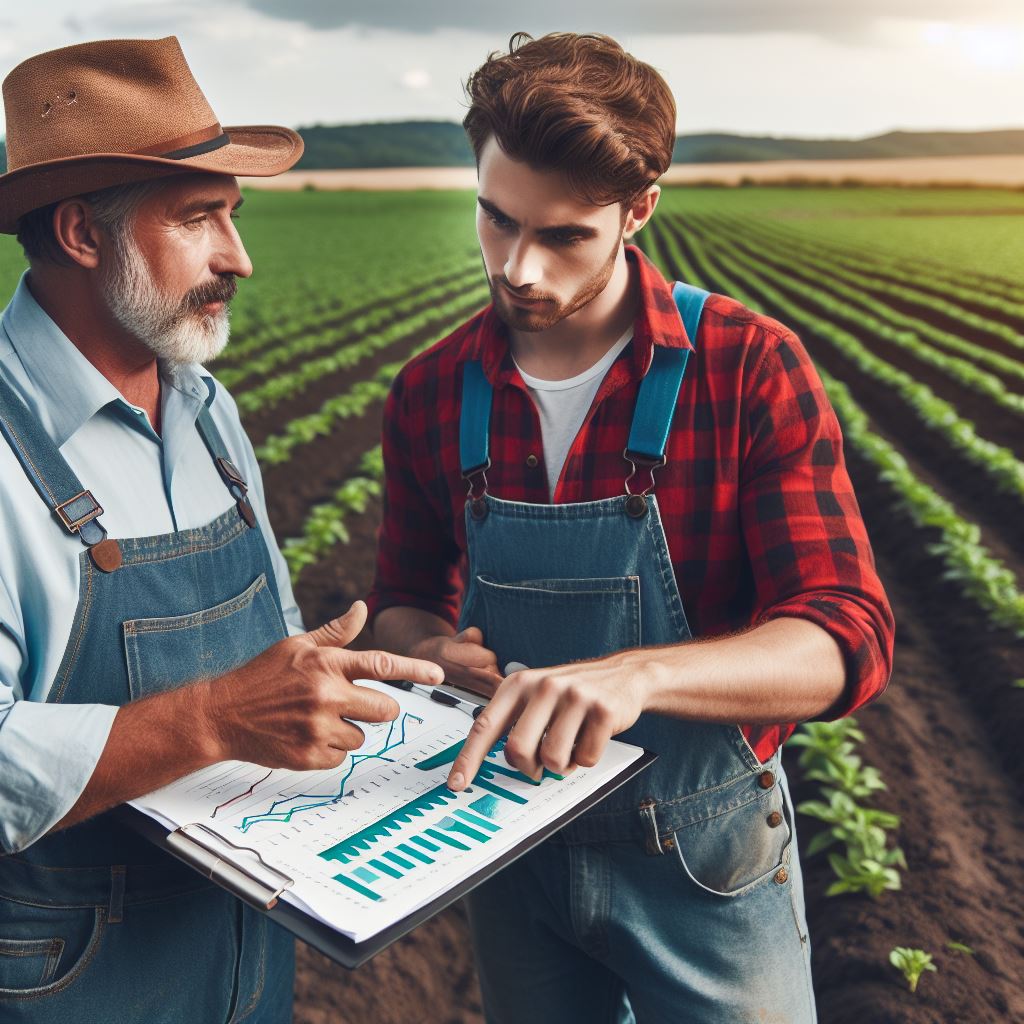Climate-Smart Soil: Adapting Farm Practices
Last Updated on January 21, 2024
Introduction
A. Climate-Smart Soil: A Paradigm Shift
Harnessing climate smart soil farm practices is pivotal for sustainable agriculture, fostering resilience against climate change.
B. Adapting Farm Practices: A Vital Necessity
In the face of evolving climate patterns, adapting farm practices becomes imperative for maintaining agricultural productivity and environmental health.
C. Unveiling the Blog’s Trajectory
- Soil-Centric Wisdom: Unraveling the significance of prioritizing soil health in the climate era.
- Farming for Tomorrow: Exploring innovative, climate-resilient agricultural methodologies.
- Case Studies: Real-world examples of successful implementation and transformative outcomes.
Embarking on this blog journey, we delve into the dynamic realm of climate-smart soil practices and their profound impact on shaping the future of agriculture.
What is Climate-Smart Soil?
A. Definition and concept
Climate-smart soil refers to agricultural practices that promote sustainable land management techniques to mitigate climate change impacts.
It involves adopting strategies that enhance soil health, resilience, and productivity while reducing greenhouse gas emissions.
B. Key principles and goals
- Conservation Agriculture: This principle focuses on minimum soil disturbance, permanent soil cover, and crop rotation to protect soil structure and improve water infiltration.
- Nutrient Management: The goal is to optimize the use of nutrients by employing precision agriculture techniques, using organic fertilizers, and minimizing nutrient losses.
- Water Management: Efficient irrigation techniques, such as drip irrigation and precision watering, are vital to reduce water consumption and maintain soil moisture.
- Carbon Sequestration: Practices like cover cropping, agroforestry, and no-till farming sequester atmospheric carbon dioxide in the soil, mitigating climate change.
- Biodiversity Enhancement: Promoting biodiversity through intercropping, companion planting, and integrating livestock in agriculture contribute to soil health and climate resilience.
C. Benefits for farmers and the environment
- Increased Resilience: Climate-smart soil practices enhance soil’s ability to withstand extreme weather events, such as droughts and heavy rains, leading to increased crop productivity and farm income stability.
- Improved Soil Health: By reducing soil erosion, enhancing organic matter content, and promoting microbial activity, climate-smart soil practices maintain soil structure and fertility.
- Ecosystem Services: These practices contribute to environmental sustainability by reducing greenhouse gas emissions, enhancing water quality, and preserving biodiversity.
- Cost Savings: Climate-smart soil practices often lead to reduced input requirements, such as fertilizers, pesticides, and irrigation water, resulting in cost savings for farmers.
- Market Access: Many consumers and international markets now prioritize sustainable farming practices, providing market advantages for farmers implementing climate-smart soil techniques.
In fact, climate-smart soil practices encompass a set of principles and goals that emphasize sustainable land management techniques to tackle the impacts of climate change.
By adopting these practices, farmers can improve soil health, increase resilience, reduce greenhouse gas emissions, and access new markets.
Implementing climate-smart soil strategies is crucial for a sustainable future, both for farmers and the environment.
Read: Crop Diversity: Soil Health Game Changer
The Role of Soil Management in Climate-Smart Practices
A. Importance of soil health for climate resilience
Soil health plays a crucial role in ensuring resilience to climate change impacts by providing stability and productivity to agricultural systems.
B. Strategies to improve soil health
- Conservation tillage: Minimizing soil disturbance through reduced tillage practices helps preserve soil structure and enhance organic matter content.
- Cover cropping: Planting cover crops during fallow periods reduces soil erosion, enhances nutrient cycling, and improves soil fertility.
- Crop rotation: Rotating crops diversifies the nutrient uptake, reduces pest pressure, and promotes overall soil health.
- Precision nutrient management: Applying fertilizers and other soil amendments in a targeted and efficient manner prevents nutrient loss and pollution, optimizing soil health.
C. Techniques to mitigate soil erosion and enhance water-holding capacity
Implementing techniques to mitigate soil erosion and enhance water-holding capacity further contributes to climate-smart soil management.
Some of these techniques include:
- Terracing: Creating terraces across slopes helps to control water flow, reducing erosion and nutrient loss.
- Contour plowing: Planting along the contour lines of a slope minimizes water runoff and soil erosion.
- Windbreaks: Establishing rows of trees or shrubs at the edges of fields helps reduce wind erosion and protects crops.
- Mulching: Applying organic or inorganic mulch to the soil surface helps retain moisture, prevent surface crusting, and control erosion.
- Conservation buffers: Planting vegetation strips, such as grass or trees, along field boundaries and water bodies helps filter runoff and prevent sediment movement.
By implementing these strategies and techniques, farmers can improve soil health, enhance climate resilience, and contribute to sustainable agricultural practices.
Adopting climate-smart soil management practices is essential to ensure food security and mitigate the adverse impacts of climate change on agricultural systems and the environment.
Read: Soil pH Balance: Key to Sustainable Growth
Climate-Smart Practices to Minimize Greenhouse Gas Emissions
A. Reducing nitrogen fertilizer use
Farm practices play a significant role in greenhouse gas emissions.
Nitrogen fertilizers, commonly used to improve crop yield, contribute to nitrous oxide emissions, a potent greenhouse gas.
However, by adopting climate-smart practices, farmers can effectively reduce the use of nitrogen fertilizers and minimize their impact on the environment.
Excessive nitrogen fertilization not only harms the environment but also affects soil health.
The excessive use of nitrogen may result in the release of excess nitrous oxide, a greenhouse gas that contributes to climate change.
To reduce nitrogen fertilizer use, farmers can adopt precision agriculture techniques.
Precision agriculture involves using advanced technologies such as GPS and remote sensing to ensure the precise application of fertilizers.
By carefully tailoring the distribution of nitrogen fertilizers to specific crop requirements, farmers can minimize nitrogen losses and reduce emissions.
B. Incorporating organic matter into the soil
Another climate-smart practice is the incorporation of organic matter into the soil.
Organic matter enhances soil fertility, improves water holding capacity, and promotes beneficial microbial activity.
Additionally, organic matter plays a crucial role in carbon sequestration, the process through which carbon dioxide is captured from the atmosphere and stored in the soil.
Farmers can incorporate organic matter into the soil by utilizing cover crops, crop residues, and livestock manure.
These practices not only enhance soil health but also contribute to mitigating climate change by sequestering carbon dioxide from the atmosphere.
C. Implementing carbon sequestration methods
1. Agroforestry
Agroforestry is an effective climate-smart practice that involves integrating trees into farming systems.
Trees play a vital role in reducing greenhouse gas emissions by sequestering carbon dioxide through photosynthesis.
Additionally, they provide multiple benefits such as shade for crops, wind protection, and habitat for beneficial insects.
By implementing agroforestry practices, farmers can sequester carbon dioxide from the atmosphere, mitigate climate change, and improve the overall sustainability of their farming systems.
2. Biochar application
Biochar is a carbon-rich material produced through the pyrolysis of organic biomass.
When applied to the soil, biochar serves as a long-term carbon sink, sequestering carbon dioxide and reducing emissions.
Moreover, biochar enhances soil fertility, water retention, and nutrient availability, thereby improving crop productivity.
Biochar can be produced from various organic waste materials such as agricultural residues, wood chips, or manure.
Its application in the soil not only reduces greenhouse gas emissions but also enhances soil health and resilience.
Incorporating climate-smart practices into farming systems is crucial to minimize greenhouse gas emissions and adapt to the changing climate.
By reducing nitrogen fertilizer use, incorporating organic matter, and implementing carbon sequestration methods like agroforestry and biochar application, farmers can contribute to a more sustainable and resilient agricultural sector.
Through these practices, farmers can not only reduce the impact of agriculture on climate change but also improve soil health, conserve natural resources, and ensure long-term food security.
Adapting farm practices to be climate-smart is not only beneficial for the environment but also for the well-being of farming communities and future generations.
Read: Green Farming: Soil Aeration Techniques
Technological Advancements Supporting Climate-Smart Agriculture
A. Use of precision agriculture tools
Precision agriculture tools have revolutionized farming practices by providing accurate data for informed decision-making.
These tools, such as drones and GPS-enabled machines, allow farmers to target specific areas of their fields.
By applying inputs only where needed, farmers can minimize waste and optimize resource use, leading to increased productivity.
Precision agriculture tools also help monitor soil conditions, allowing farmers to adjust irrigation and fertilization practices accordingly.
B. Remote sensing and data analysis for informed decision-making
Remote sensing technology, including satellites and aerial imagery, provides real-time data on crop health and growth patterns.
By analyzing this data, farmers can identify areas that require immediate attention, such as pest infestations or nutrient deficiencies.
Remote sensing also enables farmers to forecast weather patterns and anticipate climate-related challenges, helping them make proactive decisions.
With the help of data analysis tools, farmers can assess the impact of their management practices on soil health and carbon sequestration.
C. Integration of digital tools and farm management systems
The integration of digital tools and farm management systems streamlines agricultural operations and enhances efficiency.
Farm management systems centralize data from various sources, such as weather stations and sensor networks, allowing farmers to access real-time information.
These systems enable farmers to monitor soil moisture levels, crop yields, and resource use, facilitating data-driven decision-making.
Digital tools, like mobile applications, support communication and collaboration among farmers, researchers, and extension services.
Such integration allows for quick adoption of climate-smart practices and the exchange of knowledge and best practices.
In essence, technological advancements in agriculture have greatly supported climate-smart practices by enabling precise and data-driven decision-making.
The use of precision agriculture tools, remote sensing technology, and digital tools has revolutionized farming practices.
By harnessing these tools, farmers can optimize resource use, enhance productivity, and adapt to climate change challenges.
Integration of digital tools and farm management systems further enhances efficiency and collaboration among stakeholders.
As the agricultural sector continues to face the impacts of climate change, technological advancements will play a crucial role in supporting sustainable farming practices.
Read: Healthy Soil Strategies: Microbial Magic

Examples of Successful Climate-Smart Farming Practices
Case study 1: Adoption of no-till farming in New Forest Farm
At New Forest Farm, farmers have successfully implemented the practice of no-till farming.
This involves refraining from tilling the soil, which helps to retain moisture and organic matter.
Without disturbing the soil structure through tilling, the farm has seen increased water infiltration, reduced erosion, and improved soil health.
Case study 2: Implementation of cover cropping and crop rotation in Gabe Brown’s Ranch
Gabe Brown’s Ranch has become a prime example of successful climate-smart farming through the implementation of cover cropping and crop rotation.
By growing cover crops, such as legumes and grasses, the soil is protected from erosion and nutrient runoff.
In addition, crop rotation helps break pest cycles, improves soil fertility, and enhances overall ecosystem resilience.
Results and benefits observed in these farms
The adoption of climate-smart farming practices in both New Forest Farm and Gabe Brown’s Ranch has yielded numerous positive outcomes.
These include increased soil organic matter, enhanced water retention capacity, improved soil structure, and reduced greenhouse gas emissions.
Moreover, these practices have also led to higher crop yields, reduced reliance on synthetic fertilizers, and improved resilience to climate variability.
The utilization of no-till farming at New Forest Farm has resulted in notable benefits.
By avoiding soil disturbance, water infiltration has increased by 50%, reducing the need for irrigation.
Additionally, soil erosion has significantly decreased, leading to the preservation of topsoil and preventing sedimentation in nearby water bodies.
With improved soil health, the farm has experienced increased nutrient availability and natural pest control.
Gabe Brown’s implementation of cover cropping and crop rotation has showcased its advantages as well.
Cover crops have contributed to weed suppression, reducing the need for herbicides. They have also fixed nitrogen in the soil, reducing the use of synthetic fertilizers.
The rotation of crops has disrupted pest cycles, leading to reduced pest damage and subsequent pesticide use.
Furthermore, these practices have improved soil structure, water infiltration rates, and nutrient cycling.
Overall, the successful implementation of climate-smart farming practices has greatly benefited New Forest Farm and Gabe Brown’s Ranch.
These farms have demonstrated that by prioritizing soil health and adopting sustainable farming techniques, it is possible to mitigate environmental impacts, increase productivity, and build resilience in the face of climate change.
These examples serve as a valuable inspiration for farmers worldwide to embrace climate-smart soil practices in their own operations.
Potential Challenges in Adopting Climate-Smart Practices
A. Financial implications and initial investments
- The transition to climate-smart practices often requires significant financial investments.
- Farmers might find it challenging to finance the initial costs of implementing new techniques.
- Investments in efficient irrigation systems, renewable energy, and precision farming can be expensive.
- Limited access to affordable loans or financial assistance programs can hinder the adoption of climate-smart practices.
- Assistance from governments and financial institutions is crucial in overcoming these financial challenges.
B. Limited access to technological resources
- Modern farming technologies, such as precision agriculture tools, can enhance climate resilience.
- However, farmers in remote or underprivileged areas may lack access to these resources.
- The digital divide can pose a challenge as climate-smart practices often rely on sophisticated technologies.
- Improved infrastructure and technological support are necessary to bridge this gap and ensure equal opportunities.
- Collaborations between governments, NGOs, and private sectors can help provide access to technological resources.
C. Knowledge and awareness gaps among farmers
- Many farmers lack sufficient knowledge and awareness about climate-smart practices.
- They may be unaware of the potential benefits or unsure about how to implement these practices.
- Training and capacity-building programs can address these gaps and build farmers’ confidence.
- Extension services, workshops, and educational campaigns play a significant role in disseminating information.
- Sharing success stories and experiences from early adopters can inspire others to try climate-smart practices.
In general, the adoption of climate-smart practices in agriculture faces potential challenges that need to be acknowledged and addressed.
Financial implications and initial investments can be daunting for farmers, requiring support from governments and financial institutions.
Limited access to technological resources creates disparities, necessitating collaborations to bridge the digital divide.
Knowledge and awareness gaps among farmers can be overcome through training, extension services, and information dissemination.
By addressing these challenges, we can promote the widespread adoption of climate-smart soil practices and ensure a more sustainable and resilient future for agriculture.
Policy and Support Needed for Widespread Adoption
A. Government initiatives promoting climate-smart agriculture
- Government agencies should implement policies and programs that promote climate-smart agriculture.
- These initiatives can include providing funding for research and development of climate-smart soil practices.
- Government should support farmers in adopting these practices by offering technical assistance and training programs.
B. Financial incentives for farmers to implement sustainable practices
- Financial incentives, such as tax breaks or subsidies, should be provided to farmers who implement climate-smart soil practices.
- These incentives can help offset the costs associated with adopting new technologies and practices.
- Policies should be put in place to ensure that these incentives are accessible to all farmers, regardless of their financial situation.
C. Collaboration between scientists, policymakers, and farmers
- Scientists, policymakers, and farmers should work together to develop and implement climate-smart soil practices.
- Scientists can provide the necessary research and knowledge to develop effective practices.
- Policymakers can create supportive policies and regulations based on scientific findings.
- Farmers can provide insights and practical feedback on the feasibility and effectiveness of these practices.
Collaboration among these stakeholders is essential for the successful widespread adoption of climate-smart soil practices.
By working together, they can ensure that policies are well-informed, resources are accessible, and practices are practical for farmers.
This collaborative approach will help overcome barriers and challenges, and ultimately lead to a more sustainable and resilient agricultural sector.
It is important for all stakeholders to recognize the significance of climate-smart soil practices for addressing climate change and ensuring food security.
Policy and support should be put in place to encourage the adoption of these practices and facilitate their implementation at scale.
Conclusion
In this section, we discussed key points about climate-smart soil and adapting farm practices.
It is crucial for farmers to consider adopting climate-smart practices to mitigate climate change impacts.
We encourage farmers to explore and implement climate-smart soil practices on their farms for sustainable agriculture.
By using techniques like conservation tillage and cover cropping, farmers can enhance soil health and resilience.
Climate-smart practices not only improve soil health but also increase crop productivity and farm profitability.
Farmers must also take into account local conditions and consult with experts to tailor practices to their specific contexts.
It is vital for farmers to share their experiences with climate-smart soil practices to learn and inspire others.
Readers are encouraged to share their thoughts and experiences on climate-smart soil practices in the comments section.
Let’s collectively work towards building a resilient agricultural system that can withstand climate change challenges.
By adopting climate-smart soil practices, we can contribute to a sustainable future for agriculture and the planet.
Together, let’s create a community of farmers and readers who support and exchange ideas on climate-smart farming techniques.
Share this section with others who are interested in sustainable agriculture and farming practices for a greener planet.
Join the conversation and be a part of the movement towards climate-smart soil and resilient farming.
Together, we can make a difference in preserving our soils, safeguarding our food production, and mitigating climate change effects.


